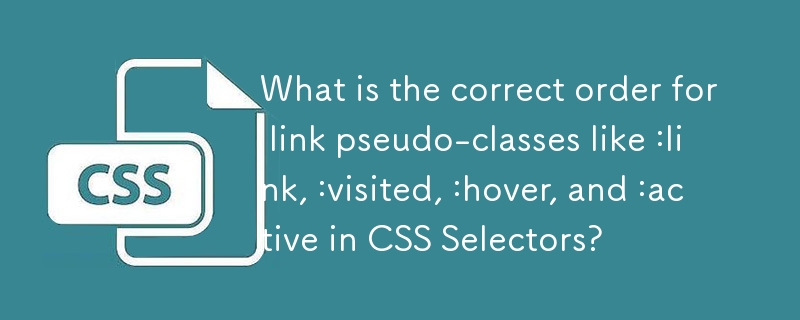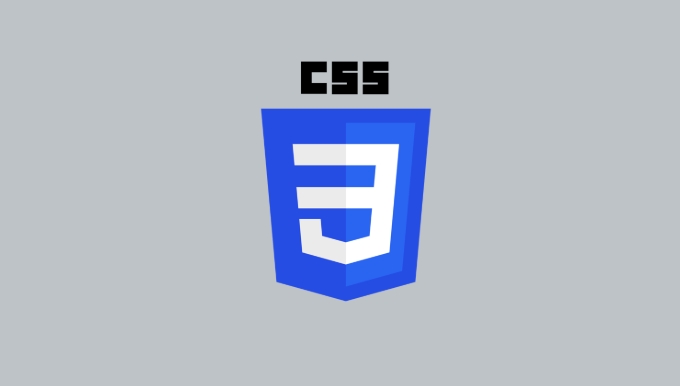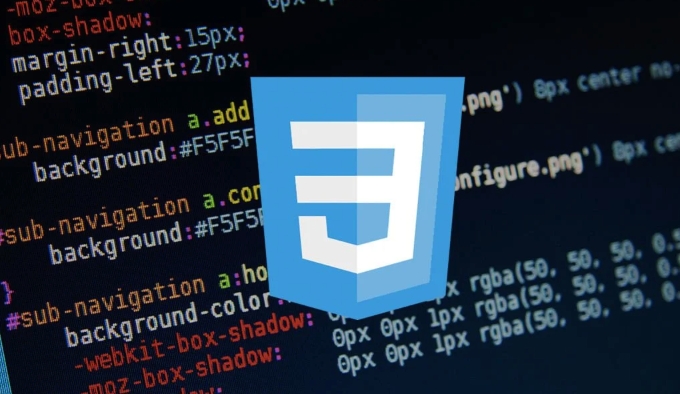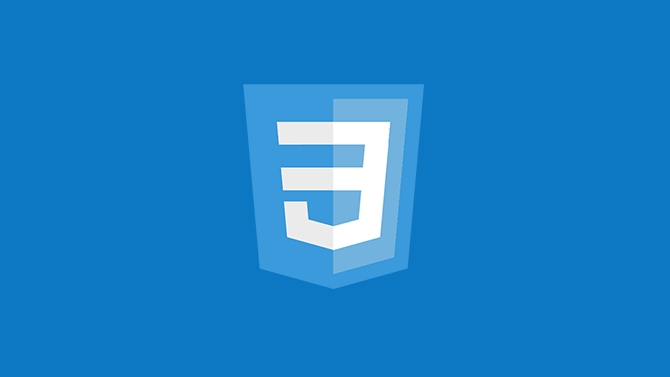 Web Front-end
Web Front-end
 CSS Tutorial
CSS Tutorial
 What is the correct order for link pseudo-classes like :link, :visited, :hover, and :active in CSS Selectors?
What is the correct order for link pseudo-classes like :link, :visited, :hover, and :active in CSS Selectors?
What is the correct order for link pseudo-classes like :link, :visited, :hover, and :active in CSS Selectors?
Jun 28, 2025 am 12:02 AMIn CSS, the order of pseudo-class selectors: link, :visited, :hover and :active are very important. They must be written in LVHA (Link → Visited → Hover → Active), because when the styles are of the same priority, the subsequent rules will override the previous one; 1. :link sets the unreached link style; 2. :visited sets the accessed link style, but is restricted by browser privacy; 3. :hover sets the mouse hover effect, and the mobile side may need additional processing; 4. :active sets the style when clicking to provide instant feedback; this order ensures that all statuses can be displayed correctly to avoid browser inconsistencies.

In CSS, :link , :visited , :hover and :active are pseudo-class selectors commonly used for link styles. The order they are written is critical because if the order is incorrect, some styles may not appear as expected.

The correct order is:

:link → :visited → :hover → :active
This is called the LVHA order (Link → Visited → Hover → Active).

Why is the order important?
The style in CSS is "latest", that is, if the two selectors have the same priority, the latter will override the previous one.
For example:
a:hover { color: blue; }
a: visited { color: purple; } If you write :hover in front of :visited , it may turn blue when the mouse is hovered over a visited link; but if written in reverse, inconsistent behavior may occur, especially in different browsers.
Therefore, in order for all states to be displayed normally, it must be written in the order of LVHA.
Recommendations on the role and usage of each pseudo-class
:link ——Unvised link
- Only effective for links that have not been clicked by users.
- It is usually used to set the default link color, such as blue.
Example:
a:link {
color: #0000EE;
} :visited —— Links visited
- Works on links that the user has visited.
- For privacy protection, modern browsers limit the types of styles that can be applied (such as not modifying certain sizes or background images).
suggestion:
- Only change the basic styles such as colors and fonts.
- Don't try to track user behavior through
:visited.
Example:
a: visited {
color: #551A8B; /* Default accessed link color*/
} :hover —— The status when the mouse is hovered
- Triggered when the user's mouse pointer moves to the link.
- It is often used to enhance interactive feedback, such as enlarging text and changing background color.
hint:
- On mobile devices
:hovermay behave inconsistently, and some require a click to "activate". - If you want the mobile terminal to have similar effects, you may need to cooperate with JavaScript or other technologies.
Example:
a:hover {
color: #FF0000;
text-decoration: underline;
} :active — When the link is activated (clicked)
- Effective when the user clicks on a link but has not released the mouse button.
- It is usually used to provide click feedback, such as darkening colors or button pressing effects.
Skill:
- This state is very short-lived, so the style changes should be obvious but not excessive.
- You can combine transition animation to improve the experience.
Example:
a:active {
color: #008000;
}Common practices in actual development
- Many developers only care about
:hoverand:active, and ignore:linkand:visited, especially internal links or no distinction between access. - When using a CSS preprocessor (such as Sass), these pseudo-classes can be nested under the main selector for clearer.
- If you are using CSS frameworks (such as Tailwind, Bootstrap), they usually have already processed the pseudo-class order of the link.
For example, in Sass:
a {
&:link { color: blue; }
&:visited { color: purple; }
&:hover { color: red; }
&:active { color: green; }
}Basically that's it. Just remember the order of LVHA, most link style conflicts can be avoided.
The above is the detailed content of What is the correct order for link pseudo-classes like :link, :visited, :hover, and :active in CSS Selectors?. For more information, please follow other related articles on the PHP Chinese website!

Hot AI Tools

Undress AI Tool
Undress images for free

Undresser.AI Undress
AI-powered app for creating realistic nude photos

AI Clothes Remover
Online AI tool for removing clothes from photos.

Clothoff.io
AI clothes remover

Video Face Swap
Swap faces in any video effortlessly with our completely free AI face swap tool!

Hot Article

Hot Tools

Notepad++7.3.1
Easy-to-use and free code editor

SublimeText3 Chinese version
Chinese version, very easy to use

Zend Studio 13.0.1
Powerful PHP integrated development environment

Dreamweaver CS6
Visual web development tools

SublimeText3 Mac version
God-level code editing software (SublimeText3)

Hot Topics
 What is 'render-blocking CSS'?
Jun 24, 2025 am 12:42 AM
What is 'render-blocking CSS'?
Jun 24, 2025 am 12:42 AM
CSS blocks page rendering because browsers view inline and external CSS as key resources by default, especially with imported stylesheets, header large amounts of inline CSS, and unoptimized media query styles. 1. Extract critical CSS and embed it into HTML; 2. Delay loading non-critical CSS through JavaScript; 3. Use media attributes to optimize loading such as print styles; 4. Compress and merge CSS to reduce requests. It is recommended to use tools to extract key CSS, combine rel="preload" asynchronous loading, and use media delayed loading reasonably to avoid excessive splitting and complex script control.
 How to use Lotties in Figma
Jun 14, 2025 am 10:17 AM
How to use Lotties in Figma
Jun 14, 2025 am 10:17 AM
In the following tutorial, I will show you how to create Lottie animations in Figma. We'll use two colorful designs to exmplify how you can animate in Figma, and then I'll show you how to go from Figma to Lottie animations. All you need is a free Fig
 Breaking Boundaries: Building a Tangram Puzzle With (S)CSS
Jun 13, 2025 am 11:33 AM
Breaking Boundaries: Building a Tangram Puzzle With (S)CSS
Jun 13, 2025 am 11:33 AM
We put it to the test and it turns out Sass can replace JavaScript, at least when it comes to low-level logic and puzzle behavior. With nothing but maps, mixins, functions, and a whole lot of math, we managed to bring our Tangram puzzle to life, no J
 External vs. Internal CSS: What's the Best Approach?
Jun 20, 2025 am 12:45 AM
External vs. Internal CSS: What's the Best Approach?
Jun 20, 2025 am 12:45 AM
ThebestapproachforCSSdependsontheproject'sspecificneeds.Forlargerprojects,externalCSSisbetterduetomaintainabilityandreusability;forsmallerprojectsorsingle-pageapplications,internalCSSmightbemoresuitable.It'scrucialtobalanceprojectsize,performanceneed
 Does my CSS must be on lower case?
Jun 19, 2025 am 12:29 AM
Does my CSS must be on lower case?
Jun 19, 2025 am 12:29 AM
No,CSSdoesnothavetobeinlowercase.However,usinglowercaseisrecommendedfor:1)Consistencyandreadability,2)Avoidingerrorsinrelatedtechnologies,3)Potentialperformancebenefits,and4)Improvedcollaborationwithinteams.
 CSS Case Sensitivity: Understanding What Matters
Jun 20, 2025 am 12:09 AM
CSS Case Sensitivity: Understanding What Matters
Jun 20, 2025 am 12:09 AM
CSSismostlycase-insensitive,butURLsandfontfamilynamesarecase-sensitive.1)Propertiesandvalueslikecolor:red;arenotcase-sensitive.2)URLsmustmatchtheserver'scase,e.g.,/images/Logo.png.3)Fontfamilynameslike'OpenSans'mustbeexact.
 What is Autoprefixer and how does it work?
Jul 02, 2025 am 01:15 AM
What is Autoprefixer and how does it work?
Jul 02, 2025 am 01:15 AM
Autoprefixer is a tool that automatically adds vendor prefixes to CSS attributes based on the target browser scope. 1. It solves the problem of manually maintaining prefixes with errors; 2. Work through the PostCSS plug-in form, parse CSS, analyze attributes that need to be prefixed, and generate code according to configuration; 3. The usage steps include installing plug-ins, setting browserslist, and enabling them in the build process; 4. Notes include not manually adding prefixes, keeping configuration updates, prefixes not all attributes, and it is recommended to use them with the preprocessor.
 What are CSS counters?
Jun 19, 2025 am 12:34 AM
What are CSS counters?
Jun 19, 2025 am 12:34 AM
CSScounterscanautomaticallynumbersectionsandlists.1)Usecounter-resettoinitialize,counter-incrementtoincrease,andcounter()orcounters()todisplayvalues.2)CombinewithJavaScriptfordynamiccontenttoensureaccurateupdates.





